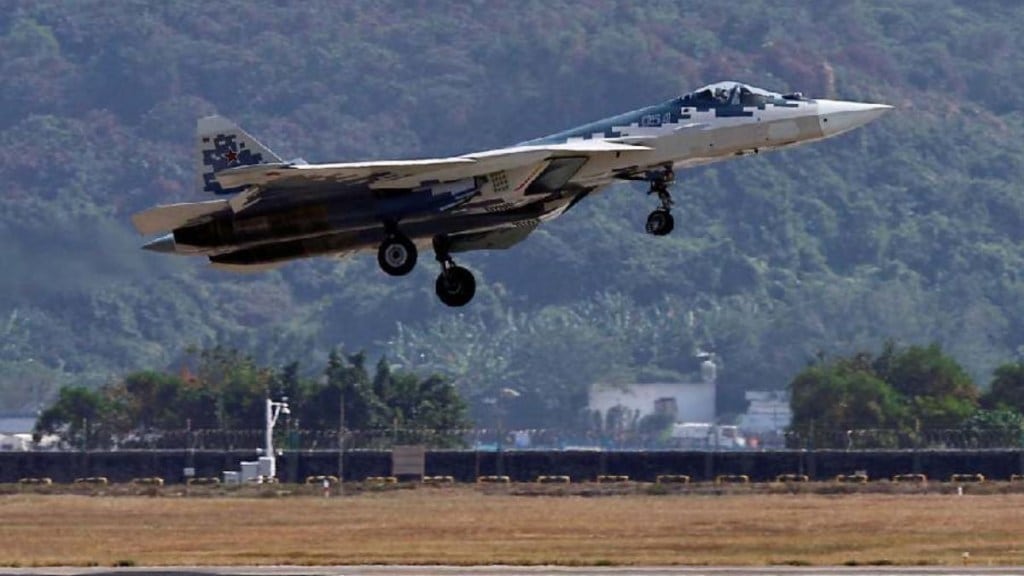As India prepares to host the Aero-India 2025 exhibition in February, all eyes will be on Russia’s Su-57 (Sukhoi-57) stealth fighter jet, which is set to make its debut appearance at the event. For aviation enthusiasts, defence analysts, and policymakers alike, this could mark a significant turning point in India’s defence landscape. The Su-57, Russia’s first fifth-generation stealth fighter, will be showcased at Yelahanka Air Force Station in Bengaluru, alongside an impressive lineup of other fighter jets from both India and around the world. However, the spotlight will likely shine brightest on this advanced aircraft, as it becomes a symbol of the growing strategic defence ties between India and Russia.
The Su-57: Russia’s Fifth-Generation Stealth Fighter
Manufactured by Sukhoi, the Su-57 is one of the most advanced stealth fighter jets in the world. The aircraft has already made its presence felt on the international stage, including at China’s Aero Show in November last year, and was recently inducted into Russia’s Air Force. As the first fifth-generation fighter jet developed by Russia, the Su-57 is expected to showcase cutting-edge capabilities in stealth, speed, and manoeuvrability—setting it apart from older fourth-generation fighter jets.
What makes the Su-57 especially intriguing is its potential strategic value to India, which has long relied on Russian defence technology. With China rapidly advancing its own military capabilities, including the introduction of its J-20 and J-35 stealth fighters, and its recent claims of developing a sixth-generation stealth bomber, India’s need for next-generation aircraft has become more pressing than ever.
Putin’s Visit and Potential Offer to India
The timing of Russian President Vladimir Putin’s anticipated visit to India could provide a unique opportunity for India to solidify its defence ties with Russia. Speculation is rife that during his visit, Putin may offer India the Su-57 as part of a larger defence cooperation deal. More significantly, the two countries may explore the possibility of co-manufacturing the Su-57 under India’s flagship “Make in India” initiative.
India has been a long-time partner of Russia in the defence sector, with the two nations collaborating on the production of the Su-30 fighter jets for over two decades. Given India’s growing emphasis on self-reliance in defence production, particularly through the Make in India program, Russia’s offer of joint manufacturing for the Su-57 could bolster India’s position in the region, ensuring a modernized and indigenous fleet of fighter jets.
The Challenge from China and the Need for Upgraded Aircraft
India’s defence priorities are increasingly shaped by the growing military capabilities of neighbouring China. China’s rapid advancements in stealth fighter technology, exemplified by its J-20 and J-35 aircraft, and its ambitious claims regarding the development of sixth-generation jets, have raised concerns in New Delhi. As China continues to enhance its defence technology, India finds itself in a race to keep up, especially in the realm of aerial combat capabilities.
Moreover, the delay in receiving crucial aviation engines from the United States has only added to India’s defence challenges. The slow delivery of engines has caused delays in the production of the Mark-1A variant of India’s indigenous LCA Tejas fighter jet, pushing the project one year behind schedule. With the growing regional threat and a delay in the LCA Tejas program, the need for advanced fighter jets, like the Su-57, has never been more critical.
India’s Air Force Chief on the Country’s Aviation Deficit
Addressing the increasing gap in military aviation capabilities, Indian Air Force (IAF) Chief Air Chief Marshal AP Singh recently expressed concern over India’s lag behind China in both aviation technology and production of fighter aircraft. He advocated for greater participation of private companies in India’s aerospace sector, alongside government-owned entities like Hindustan Aeronautics Limited (HAL), to accelerate the production of state-of-the-art aircraft and reduce dependency on foreign suppliers.
The chief’s comments underscore the urgency of diversifying and modernizing India’s air combat fleet. For India to regain its strategic advantage, particularly against adversaries like China and Pakistan, it will need to adopt cutting-edge technologies and increase its self-sufficiency in defence production.
What’s Next for India and the Su-57?
As Aero-India 2025 approaches, the Su-57’s debut will be closely watched by global defence experts and military strategists. The aircraft’s inclusion in the exhibition provides a rare opportunity for India to evaluate Russia’s most advanced fighter jet and determine its potential fit within the Indian Air Force’s future combat fleet.
If Putin offers the Su-57 during his visit to India, it could lead to a new phase in defence cooperation between the two countries, centered around joint manufacturing and the development of next-generation aircraft that could counter China’s growing military presence in the region. With an eye on its defence modernization, India may also push for faster delivery timelines and greater involvement of domestic aerospace companies in the production process.
The outcome of these discussions will have long-term implications for India’s strategic position in the Indo-Pacific and its efforts to balance the military power dynamics in the region. As global superpowers like China and the US continue to develop and deploy cutting-edge military technology, India’s decision to move forward with a modernized fleet of stealth aircraft like the Su-57 could be pivotal in ensuring its air superiority in the years to come.

